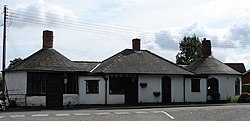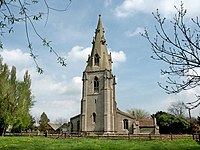Anwick
| Anwick | |
| Lincolnshire | |
|---|---|
 Anwick Forge, Anwick | |
| Location | |
| Grid reference: | TF114504 |
| Location: | 53°2’24"N, 0°20’21"W |
| Data | |
| Population: | 392 (2011) |
| Post town: | Sleaford |
| Postcode: | NG34 |
| Local Government | |
| Council: | North Kesteven |
| Parliamentary constituency: |
Sleaford and North Hykeham |
Anwick is a small village in Kesteven, the south-western part of Lincolnshire. The population of the civil parish at the 2011 census was 394. The village is to be found four miles north-east of Sleaford, on the A153 between Sleaford and Billinghay, and sixteen miles south-east of the county town, the City of Lincoln.
History
Anwick is mentioned in the 1086 Domesday Book as "Amuinc" and "Haniwic". The manor had 29 households with 5 villeins, 3 smallholders and 21 freemen, and 6 ploughlands. In 1066 Lord of the Manor was Toki son of Auti; by 1086 the lordship was held by Ralph, nephew of Geoffrey Alselin, and Drogo of la Beuvrière. Tenancy-in-chief of manorial land was part held by la Beuvrière and part by Alselin.
Anwick was described in John Marius Wilson's 1870-72 Imperial Gazetteer of England and Wales as:
a parish in Sleaford district, Lincoln; near the Sleaford canal, 4½ miles ENE of Sleaford r. station. Post Town, Sleaford. Acres, 1,820. Real property, £2,773. Pop., 277. Houses, 58. The property is divided among a few. The living is a vicarage annexed to the rectory of Brauncewell, in the diocese of Lincoln. The church is good".
In 1885 Kelly's Directory noted the parish as part of the Sleaford Poor Law Union. The principal landowner was The Marquess of Bristol. Chief crops were wheat, beans, barley, turnips and seeds [potatoes], in a parish area of 2,019 acres. Population in 1881 was 348.[1]
RAF Anwick
During the First World War there was a Royal Flying Corps airfield north of the village. It was later named RAF Anwick, and was occasionally laid-out with a decoy airstrip during the Second World War in an effort to confuse enemy airmen that they were overhead RAF Digby airfield, a genuine fighter airfield.
Sights of the village

The parish church of St Edith is a Grade I listed early English church dating to the late 13th or early 14th centuries. The church was restored in 1859 and the spire rebuilt in 1906 after being struck by lightning.[2] Two glacial erratic boulders, the Drake Stones, lie next to the churchyard.[3]
Anwick has a old forge in the centre of the village, over two hundred years old and which is said to be designed by architect John Nash. The forge is still a traditional blacksmith shop to this day.
Anwick also has a chicken-processing factory, a garden centre, a low-security independent hospital for men, and a private airstrip on nearby arable land (unrelated to the Second World War dummy airfield and on a different site).
Outside links
| ("Wikimedia Commons" has material about Anwick) |
- The Drake Stones, Themodernantiquarian.com. Retrieved 23 June 2011
- Anwick in the Domesday Book
References
- ↑ Kelly's Directory of Lincolnshire with the port of Hull 1885, pp.281, 282
- ↑ National Heritage List 1061829: Church of St Edith
- ↑ Drake Stones
